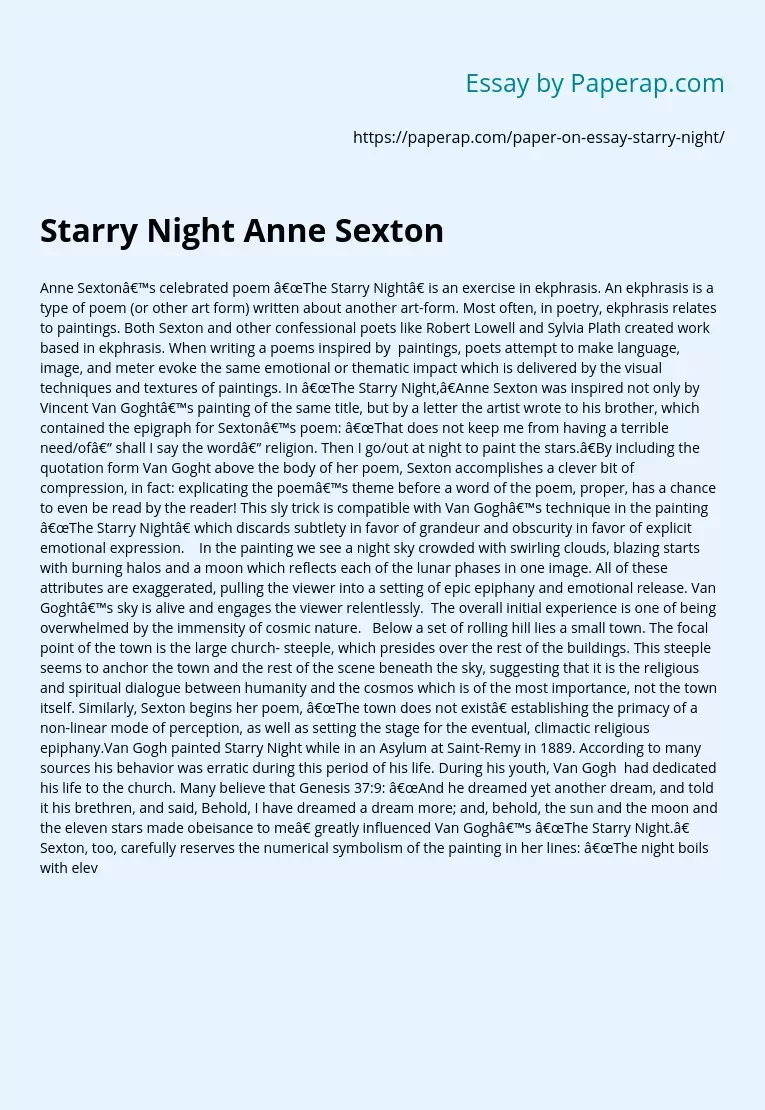Starry Night Anne Sexton
Anne Sexton’s celebrated poem “The Starry Night” is an exercise in ekphrasis. An ekphrasis is a type of poem (or other art form) written about another art-form. Most often, in poetry, ekphrasis relates to paintings. Both Sexton and other confessional poets like Robert Lowell and Sylvia Plath created work based in ekphrasis. When writing a poems inspired by paintings, poets attempt to make language, image, and meter evoke the same emotional or thematic impact which is delivered by the visual techniques and textures of paintings.
In “The Starry Night,”Anne Sexton was inspired not only by Vincent Van Goght’s painting of the same title, but by a letter the artist wrote to his brother, which contained the epigraph for Sexton’s poem: “That does not keep me from having a terrible need/of— shall I say the word— religion. Then I go/out at night to paint the stars.”By including the quotation form Van Goght above the body of her poem, Sexton accomplishes a clever bit of compression, in fact: explicating the poem’s theme before a word of the poem, proper, has a chance to even be read by the reader! This sly trick is compatible with Van Gogh’s technique in the painting “The Starry Night” which discards subtlety in favor of grandeur and obscurity in favor of explicit emotional expression.
In the painting we see a night sky crowded with swirling clouds, blazing starts with burning halos and a moon which reflects each of the lunar phases in one image.
All of these attributes are exaggerated, pulling the viewer into a setting of epic epiphany and emotional release. Van Goght’s sky is alive and engages the viewer relentlessly. The overall initial experience is one of being overwhelmed by the immensity of cosmic nature. Below a set of rolling hill lies a small town. The focal point of the town is the large church- steeple, which presides over the rest of the buildings. This steeple seems to anchor the town and the rest of the scene beneath the sky, suggesting that it is the religious and spiritual dialogue between humanity and the cosmos which is of the most importance, not the town itself. Similarly, Sexton begins her poem, “The town does not exist” establishing the primacy of a non-linear mode of perception, as well as setting the stage for the eventual, climactic religious epiphany.Van Gogh painted Starry Night while in an Asylum at Saint-Remy in 1889. According to many sources his behavior was erratic during this period of his life. During his youth, Van Gogh had dedicated his life to the church. Many believe that Genesis 37:9: “And he dreamed yet another dream, and told it his brethren, and said, Behold, I have dreamed a dream more; and, behold, the sun and the moon and the eleven stars made obeisance to me” greatly influenced Van Gogh’s “The Starry Night.” Sexton, too, carefully reserves the numerical symbolism of the painting in her lines: “The night boils with eleven stars./Oh starry starry night! This is how/I want to die!”By repeating the adjective “starry,” Sexton gains the “crowded” feeling of Van Gogh’s canvas in her stanza. She grasps the “living sky” element in the following lines: “It moves. They are all alive./Even the moon bulges in its orange irons.” The key to Sexton’s masterful ekphrasis seems to lie in her use of compressed diction: “The old unseen serpent swallows up the stars.”This, like Van Gogh’s hurried, thick brush stroked invokes a sense of both urgency and passion. Sexton’s use of the refrain “This is how I want to die!” encapsulates the theme of Van Gogh’s paining, that of religious ecstacy, by merging the erotic/death urge so common in Elizabethan poetry and here marked by an additional shading of surrealism “sucked up by that great dragon, to split/from my life with no flag.” In so doing, Sexton remains true to her confessional mode, also capturing an element which is perhaps understated in Van Gogh’s original, but present nonetheless, a “confession” of deep loneliness and alienation, marked by the darker swirls of color on the painting’s peripheries and also by the lone black tree, which Sexton describes as “a drowned woman” marking for posterity her close identification with the emotional confessional and religious themes of Van Gogh’s painting. Sexton’s poem is a wonderful counterpoint to Van Gogh’s painting, a rich example of the artistic and expressive potential of transposing the themes textures and techniques from one art medium to another.
Starry Night Anne Sexton. (2019, Dec 05). Retrieved from https://paperap.com/paper-on-essay-starry-night/

